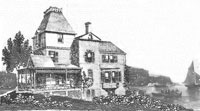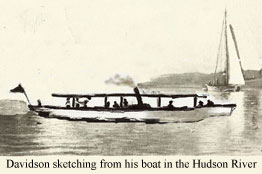Painting Style and Reviews
Julian O. Davidson painted primarily with oils on canvas. His compositions, palette and style were all influenced by the Dutch marine school, and his inclusion of small figurative scenes reflects the influence of the English school. Davidson's works retain the old world painterly craft and discipline, but he rebelled against European "cultural colonialism" and added a vigorous new element associated with the Hudson River Artists; i.e. that of man contemplating his own place in nature. This almost spiritual element is rarely seen in paintings of battles. Critics have had much to say about Davidson's style: (a) "Almost unique to his painting is the element of vigorous movement and vitality. Davidson's method of applying the paint, with areas of glazing contrasting with areas of broad, sweeping brush strokes and gentle impasto, generates a feeling of life and action. His paintings are in reality as vital, powerful and forceful as was the man himsel" Many times his physical vigor, muscular strength, energy and athletic prowess, coupled with his obvious strong pride in America, has been likened to those same qualities found in President Theodore Roosevelt" (Beman, 30). (b) "Julian O. Davidson". was a true heir of the Hudson River tradition"his work is divided clearly between the marine subjects which were intended for a popular audience and the ambitious historical paintings that became his masterpieces". The great historic naval engagements that he committed to canvases of almost unprecedented size surely remain his raison-d'etre as an artist" (Hoops, in Beman, Forward). (c) According to the 19th century contemporary art critic Fredrick Hopkins Smith, "Davidson displayed more knowledge of early American shipping than did any other artist of the period" (Beman, 25).
(d) With the invention of the steam engine and metal-hulled boats in the latter part of the 19th century, the social elite and patrons of the arts suddenly lost their taste for Tall Ships as artistic subjects. As these magnificent but "old fashioned" sailing ships disappeared from marine landscapes around the world, both sailors' and artists' knowledge of the complexities of wind navigation was lost. Styles changed in American architecture and pictureframing as well. The value of art fluctuates with social trends and fads, but Davidson's paintings will always be paramount in their understanding of the complexities, realities and beauty of sailing. They will remain among America's national treasures. Davidson completed an impressive series of large paintings depicting the major naval battles in the War of 1812 including The United States Frigate and Macedonian; Privateer Dolphin captures HMS Hebe and her Consort; USS Constitution Escaping the British; Capture of British Ship Guerriere by US frigate Constitution; and The Battle of Lake Champlain. Of this series, Perry's Victory in the Battle of Lake Erie stands out as Davidson's masterpiece. Biography-1853-1894Biography excerpted from Beman, Lynn S. Julian O. Davidson, 1853 – 1894: American Marine Artist. New City, NY: The Historical Society of Rockland County. 1986.
"While still a boy, Julian made five voyages to Cuba [with his father, who was supervising the construction of the Havana railroad.] On the last of these trips, [Julian was] shipwrecked in a severe storm. This adventure only increased his love of the ocean and ships"(Beman, 14). From the ages of 11-16, Julian attended the Rectory School, a college preparatory boarding school in Hamden, Connecticut. "The boys at the school wore grey military uniforms fashioned after those of West Point, and military drill was part of their daily life"(13). In addition to studying Latin, math, science, literature, drawing, political history, and military history, Davidson may have learned here about the War of 1812 and the Battle of Lake Erie from teachers who had been officers or who had fought with Perry in that battle. Julian also developed a life long interest in sports such at boxing, fencing and rowing. Upon graduation at 16, he apprenticed with his father's New York City firm as a surveyor and draughtsman, but found that he preferred to spend time sketching ships in New York harbor. By age 17, Julian had run away to sea by hiring on as a crewmember on the Arizona, an old-fashioned side-wheeler steamship traveling to the Orient by way of the Mediterranean Davidson often spent time visiting Nyack on the Hudson, twenty miles north of New York City, which was known for its small shipbuilding industry and casual social lifestyle. During one of his frequent Nyack stays, he met Cornelia Merritt at church. Her father was a prominent businessman in Plattsburgh, New York, where, coincidentally, Julian's mother had been born. Davidson was both skilled and prolific in rendering popular sailing sports, fishing boats, and historic battles. Publishers including Louis Prang and George Barrie recognized Julian's commercial appeal and frequently commissioned him to produce sets and series of illustrations, calendars, and even children's books. Harper's alone published several hundred of his illustrations. Davidson painted several large fifteen to twenty foot paintings of famous naval battle, one of which hung in the famous Plaza Hotel; its whereabouts isunknown today. Before starting major paintings, Julian spent years in research. "To accurately paint past naval battles required not only great knowledge of naval architecture and of the sea, but a great deal of research into the actual details of the events"Of all the artists who worked during this era, only Julian O. Davidson would throughout his career specialize in historical naval paintings" During his lifetime, (Davidson was) acknowledged by critics, writers Julian lived a very active, athletic, healthy life until he became ill with a strep infection that damaged his kidneys and eventually caused congestive heart failure. He died on April 30, 1894, at the age of 41. Very appropriately, his body was taken from Nyack to Yonkers across the Hudson River by a side-wheel steamer and then buried next to his infant son at the Woodlawn Cemetery, in Fordham, New York. He was survived by his wife, Cornelia Davidson. Return to TopCatalog of Works:The most recent comprehensive exhibition of Davidson's paintings, drawings, steel engravings, chromolithographs and wood engravings was presented at The Historical Society of Rockland County in 1986. Julian O. Davidson's historical naval battle series depicting the War of 1812 emphasizes the bravery of their leaders, men and the complexities of tall ships navigation. The series includes: The Battle of Lake Erie; The United States Frigate and Macedonian; Privateer Dolphin captures HMS Hebe and her Consort; USS Constitution Escaping the British; capture of British Ship Guerriere by US frigate Constitution; The Battle of Lake Champlain. Of this series, Perry's Victory in the Battle of Lake Erie stands out as Davidson's masterpiece.
Published Catalog of Works: Provenance of: Perry's Victory, The Battle of Lake Erie
Additional information available upon request. Exhibitions of other work:
BattleOfLakeErieArt.com As Reference On Wikipedia Beman, L.S. Julian O. Davidson (1853-1894): American Marine Artist. New City, NY: Historical Society of Rockland County. 1986. Dillon, R. We Have Met the Enemy: Oliver Hazard Perry: Wilderness Commodore. NY: McGraw Hill. 1978. Ernst, R.E. Map of the Battle of Lake Erie. Lakeside, Ohio. 1972. Important American Paintings, Drawings and Sculpture of the 18th, 19th, and 20th Centuries. NY: Christies, Manson, and Woods International, Inc. 1992. Lossing, B. Pictorial Field-Book of the War of 1812. NY: 1868, pp.524-527. Quoted in Important American Paintings, Drawings and Sculpture of the 18th, 19th, and 20th Centuries. NY: Christies, Manson and Woods International, Inc. 1992. “Niagara.” Pamphlet published by the Flagship Niagara, Erie, Pennsylvania. 1990. Pennsylvania Historical and Museum Commission. United States Brig Niagara Restoration. 1988. Rosenberg, M. The Building of Perry’s Fleet on Lake Erie: 1812 – 1813. Harrisburg: Pennsylvania Historical and Museum Commission. 1997. Seitz, R. and B. Pennsylvania’s Historic Places. Intercourse, PA: Good Books. 1989. Vaillant, J. The Golden Spruce. NY: W.W. Norton & Company. 2005. Wilmerding, J. American Marine Painting, Second Edition. NY: Harry Abrams. 1987. |



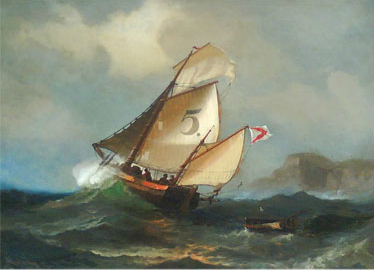
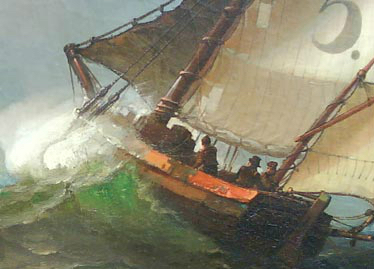
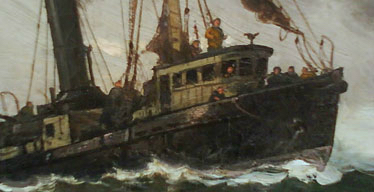
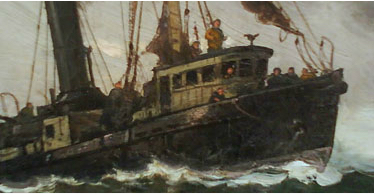

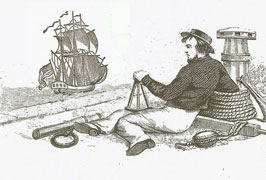 and the Suez Canal. Assisting the engineer, ship's boy, and storekeeper, he gained a great deal of practical knowledge and returned home with paintings and journals filled with sketches of sails, rigging, sailing ships and water. He rejoined his family in Fordham, a suburb of New York City, and eventually rented an apartment in Manhattan, spending two years studying with the Dutch artist, Mauritz De Hass. "Davidson painted in De Hass' studiolocated in the famed Tenth Street Studio Building in New York City"where he came into direct contact with men such as Winslow Homer, Frederick Church, William Bradford, Albert Bierstadt and Stanford R. Gifford" (Beman, 16).
and the Suez Canal. Assisting the engineer, ship's boy, and storekeeper, he gained a great deal of practical knowledge and returned home with paintings and journals filled with sketches of sails, rigging, sailing ships and water. He rejoined his family in Fordham, a suburb of New York City, and eventually rented an apartment in Manhattan, spending two years studying with the Dutch artist, Mauritz De Hass. "Davidson painted in De Hass' studiolocated in the famed Tenth Street Studio Building in New York City"where he came into direct contact with men such as Winslow Homer, Frederick Church, William Bradford, Albert Bierstadt and Stanford R. Gifford" (Beman, 16).